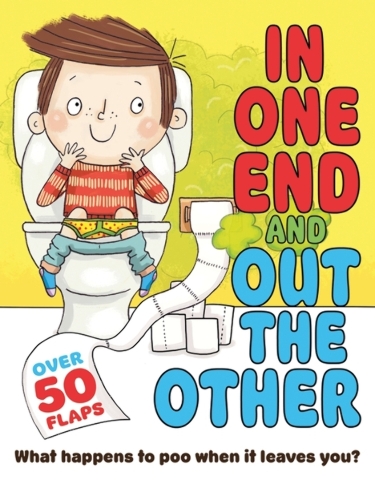‘In One End and Out the Other’ is flush with facts

You are a big kid.
No, you’re not a baby anymore. You can tie your shoes, comb your own hair, and nobody needs to feed you. You can even use the potty by yourself — but what happens after you do? In the book “In One End and Out the Other” by Dr. Mike Goldsmith, illustrated by Richard Watson, you’ll find out.
So let’s say you’re hungry, and Mom hands you an apple. Just like gasoline in a car, food is fuel for your body, and the first step in making that fuel is the spit in your mouth that helps “mush up the food.”
Once you’ve finished a bite of your apple and swallowed, the “gloopy” mixture goes down your esophagus and, 10 seconds later, it enters your stomach, where it becomes something called “chyme.” Your stomach works the chyme, then sends it to your small intestines, where nutrients are absorbed and, about seven hours later, it enters your large intestines, where water is removed. After another day or so, digestion is complete, and you’ll be ready to flush what’s left down the toilet. Did you know that you’ll spend at least three months of your life sitting on the potty?
But once you push the flusher … then what?
Everything you flush goes down a long pipe, through your house, under the ground and into a sewer pipe. There, it mixes with water and things that other people have flushed; the water moves it all below the streets into the sewage treatment plant where it gets dumped through screens into chambers and becomes sludge.
Then, says Dr. Goldsmith, “germs break down the sludge in the same way your body breaks down food.”
At some sewage plants, sludge gets dried and becomes food for plants, while “dirty water” is cleaned with “good bacteria” that makes it safe to put back into rivers or to use on lawns and fields. Other sewage plants do different things with the waste they receive, but it’s all treated so it’s safe and won’t hurt people or animals.
You thought you could breathe a sigh of relief once Potty Training was over, but then your child began asking questions that you couldn’t quite answer. That’s when you need “In One End and Out the Other.”
With a mix of words kids feel comfortable using, and real technical and medical terms, Goldsmith explains what happens from mouth to months later, not only for humans but for plants and animals as well. This information — and the trivial bits that accompany it — is helped along by illustrations by Watson, both in the main part of the book and in the fun-to-find flaps that give kids even more knowledge about the everyday function of their bodies and their cities.
Even though I’m well beyond the target age of this book (5- to 7-year-olds), I learned a lot from it, and I think your kids undoubtedly will, too. If you’re looking for answers to stICKY questions, “In One End and Out the Other” is flush with facts.
— View publishes Terri Schlichenmeyer’s reviews of books for children weekly.